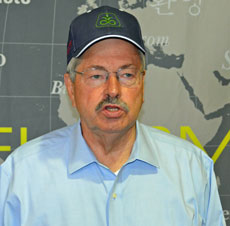 EPCE, the Energy Providers Coalition for Education, and its founding education partner, the Bismarck State College (BSC) National Energy Center for Excellence have announced the newest addition to their high-quality energy education resources – the Nuclear Pressurized Water Reactor (PWR) online simulator. This simulator is integrated into BSC’s online Nuclear Power Technology curriculum designed to educate a pipeline of employees for the nuclear power industry. This simulator includes all the aspects of an actual nuclear power plant.
EPCE, the Energy Providers Coalition for Education, and its founding education partner, the Bismarck State College (BSC) National Energy Center for Excellence have announced the newest addition to their high-quality energy education resources – the Nuclear Pressurized Water Reactor (PWR) online simulator. This simulator is integrated into BSC’s online Nuclear Power Technology curriculum designed to educate a pipeline of employees for the nuclear power industry. This simulator includes all the aspects of an actual nuclear power plant.- Environmental Defense Fund (EDF) has announced the launch of a major new campaign, Defend Our Future, that will focus on motivating young voters to show their support for climate action at the ballot box. The campaign will begin with a two million dollar voter turnout effort in Colorado aimed at demonstrating the power of young voters who care solving climate change.
- Yingli Green Energy Holding Company Limited, known as “Yingli Solar,” has announced that they have partnered with renewable energy developer Push Energy Ltd. to supply Yingli Solar’s multicyrstalline modules for four large-scale PV power plants in the United Kingdom.
- Cougar Solar, the UK’s premier source for solar powered gadgets and devices is set to launch a new magazine come September 2014. The main goal of the magazine is to be a primary source of information for all things solar energy related in the UK and internationally. The magazine is aimed at individuals and businesses alike, to be both educative and informative.

CHS Supports Cenex Tank Program to Boost E15
CHS has developed a new program to better enable some of the 1,400 Cenex branded locations across the country to meet consumer demand for E15 ethanol fuel blend. “We are excited to offer a new Cenex® Tank Program, which further demonstrates CHS leadership in renewable fuels and helps keep the Cenex brand at the forefront in meeting consumer demand for ethanol blends,” said Doug Dorfman, CHS vice president – refined fuels.
 The Cenex Tank Program will cover a significant portion of the cost to purchase and install an additional storage tank for the purpose of offering E15 for interested retailers. The Cenex network was one of the first to begin offering mid-level ethanol blends and according to Dorfman, the stations have seen significant increases in ethanol sales.
The Cenex Tank Program will cover a significant portion of the cost to purchase and install an additional storage tank for the purpose of offering E15 for interested retailers. The Cenex network was one of the first to begin offering mid-level ethanol blends and according to Dorfman, the stations have seen significant increases in ethanol sales.
“Growth Energy applauds CHS Inc. and Cenex for their steadfast commitment to renewable fuels and their announcement of the Cenex Tank Program, which will better enable some of the 1,400 Cenex branded locations to meet consumer demands for E15,” said Tom Buis, CEO of Growth Energy in response to the news. “The new program will cover a substantial part of the cost to obtain and install an additional E15 storage tank for retailers interested in expanding their offerings.”
Buis continued, “Their decision also demonstrates the strength of consumer demand for higher ethanol blends such as E15. It proves once again that consumers will select a high performance, low cost fuel when given the choice. Cenex is clearly a leader in the marketplace and is acutely in tune with what their customers want and need. I am impressed by all that Cenex is doing for our consumers and our country. They are empowering consumers with the ability to improve our environment and increase our nation’s energy and national security, all while saving money at the pump.”
Currently, E15 is available at more than 90 stations. The locations are spread between 14 states including: Wis., S.D., Ohio, Neb., N.D., N.C., Mo., Minn., Miss., Kan., Ind., Ill., Iowa and Ariz.
Algae-Biodiesel By-Product to Power Electric Grand Prix
 A grand prix racing series, the world’s first to run on electric power, will get its energy from a by-product of algae-biodiesel production. This article from GreenBiz.com says the Formula E races will use U.K.-based Aquafuel’s glycerine to power generators.
A grand prix racing series, the world’s first to run on electric power, will get its energy from a by-product of algae-biodiesel production. This article from GreenBiz.com says the Formula E races will use U.K.-based Aquafuel’s glycerine to power generators.
“It’s a very innovative compound,” [Formula E’s sustainability manager Julia] Pallé said at an event at Donington Park last week to unveil some new technologies used by Formula E. “It comes from algae so it’s a first generation compound and it uses glycerine so it has no CO2 emissions, no smoke, no noise, no smell. It’s something that isn’t harmful at all. It’s super-efficient and we’re really happy to be working with [Aquafuel] on that.”
Aquafuel chief executive Paul Day told BusinessGreen in 2011 that glycerine could power everything from generators to ships, calculating that a saltwater algal pond the size of Switzerland would meet global energy demand.
The Formula E races start Sept. 13 in Beijing, and include locations such as Miami, Buenos Aires, Monte Carlo, Berlin, and London.
Bluesphere Plans to Turn Landfill Methane into Power
 Israel-based Bluesphere Corp. has announced a plan to convert the methane gas coming off U.S. landfills into clean energy. Company officials say it can be done with technology that is already available.
Israel-based Bluesphere Corp. has announced a plan to convert the methane gas coming off U.S. landfills into clean energy. Company officials say it can be done with technology that is already available.
Methane can be converted into energy by drilling pipes into the landfill. Through these pipes methane is directed into a gas turbine or internal combustion engine which converts the gas into electricity. The electricity can either be used on-site or sold to the local electric utility and fed into the grid.
Bluesphere CEO Shlomi Palas commented, “A large number of the landfills in the U.S., particularly in the southeastern region, are not productively using methane gas emitted from landfills. These landfills are the oil fields of the future.”
“We believe we can offer a very favorable partnership to current landfill owners by providing the equipment, expertise, and power purchase agreements to convert what is now an unused asset, methane gas, into a revenue stream. We’ve been in talks with state representatives looking to increase green energy production and reduce methane emissions. They have invited and welcomed our efforts to work with landfill owners in their jurisdictions on methane-to-electricity conversions.”
Bluesphere officials believe this is a win-win-win-win situation, as they’ll generate revenues for landfill owners and Bluesphere, while cleaning up the environment AND generating clean, renewable energy.
Natural Gas, Solar & Wind Biggest Power Generation Additions
 Some clean renewables and alternatives to petroleum have added the most power-generating capacity in the first half of this year. The U.S. Energy Information Administration says out of the 4,350 megawatts of new utility-scale generating capacity to come online in the first six months of 2014, natural gas plants made up more than half of the additions, with solar and wind making up more than 25 percent and about 16 percent respectively.
Some clean renewables and alternatives to petroleum have added the most power-generating capacity in the first half of this year. The U.S. Energy Information Administration says out of the 4,350 megawatts of new utility-scale generating capacity to come online in the first six months of 2014, natural gas plants made up more than half of the additions, with solar and wind making up more than 25 percent and about 16 percent respectively.
Natural Gas
Four plants accounted for the combined-cycle capacity additions — the new Riviera plant (1,212 MW) in Florida, expansions at the Lake Side Power Plant (629 MW) in Utah, and the Channel Energy Center (183 MW) and the Deer Park Energy Center (155 MW), both in Texas.
Significantly fewer combustion turbine plants were added (130 MW) compared to last year (3,120 MW), making the June 2014 year-to-date additions of natural gas plants overall about half the level of the same period last year.
Solar
Solar additions experienced strong year-on-year growth, with nearly 70% more additions in the first half of 2014 (1,150 MW) than in the same period last year (690 MW). About three-quarters of this solar capacity was located in California, with Arizona, Nevada, and Massachusetts making up most of the rest.
Wind
Wind additions (675 MW) were more than double the amount added in the same period last year (330 MW) and were concentrated in California, Nebraska, Michigan, and Minnesota.
California’s 228 MW of capacity additions came from the Alta Wind X and Alta Wind XI projects of the Alta Wind Energy Center (currently the largest wind farm in the United States at 1,548 MW of total capacity), while Nebraska’s 207 MW came from the Prairie Breeze wind farm. In Michigan, 61 MW of the Echo Wind Park plant came online as well as the 75-MW Pheasant Run II plant. In Minnesota, the 50-MW Lakeswind plant came online.
You can read the full EIA monthly report here.
Iowa Gov Blames EPA for Deere Layoffs
 Iowa Governor Terry Branstad paid a visit to the 2014 Farm Progress Show Tuesday and had some harsh words for the Environmental Protection Agency, which just last week sent a final version of the 2014 volume requirements under the Renewable Fuel Standard to the White House for review. He blames uncertainty created by the proposed rule for the recent layoffs at Deere and Company. “The result is the price of corn has dropped so much that farmers are not buying equipment,” he said. “What the EPA has done is not only damaging farm income, but it’s costing us jobs in farm machinery and manufacturing.” Deere announced more than 100 people will be laid off indefinitely from its plant in Ankeny and 460 people will be laid off at its tractor factory in Waterloo.
Iowa Governor Terry Branstad paid a visit to the 2014 Farm Progress Show Tuesday and had some harsh words for the Environmental Protection Agency, which just last week sent a final version of the 2014 volume requirements under the Renewable Fuel Standard to the White House for review. He blames uncertainty created by the proposed rule for the recent layoffs at Deere and Company. “The result is the price of corn has dropped so much that farmers are not buying equipment,” he said. “What the EPA has done is not only damaging farm income, but it’s costing us jobs in farm machinery and manufacturing.” Deere announced more than 100 people will be laid off indefinitely from its plant in Ankeny and 460 people will be laid off at its tractor factory in Waterloo.
Branstad also notes that cellulosic and other advanced biofuels production is moving forward with the first gallons produced this summer by Quad county corn processors and two more plants opening soon. “I’m going to the POET grand opening of their new cellulosic ethanol plant and then we have DuPont Pioneer that’s also opening one in Nevada,” he said. “The problem is the oil companies control the distribution and they’ve done everything they can to discourage retailers from offering blender pumps and E15 because ethanol is a lot cheaper than gasoline.”
Listen to my interview with the Governor here: Interview with Iowa Governor Terry Branstad
BioEnergy Bytes
 The Export-Import Bank of the United States (Ex-Im Bank) has authorized a pair of direct loans to two wind power projects in Peru for the export of wind turbines manufactured in Hutchinson, Kansas, and Fort Madison, Iowa, by Siemens Energy Inc. The financing, almost $65 million in total, represents Ex-Im Bank’s first renewable-energy transactions in Peru and will support approximately 800 U.S. jobs in Kansas and Iowa, according to bank estimates derived from Departments of Commerce and Labor data and methodology. Additionally, 20 percent of each transaction should provide indirect support to small-business exporters.
The Export-Import Bank of the United States (Ex-Im Bank) has authorized a pair of direct loans to two wind power projects in Peru for the export of wind turbines manufactured in Hutchinson, Kansas, and Fort Madison, Iowa, by Siemens Energy Inc. The financing, almost $65 million in total, represents Ex-Im Bank’s first renewable-energy transactions in Peru and will support approximately 800 U.S. jobs in Kansas and Iowa, according to bank estimates derived from Departments of Commerce and Labor data and methodology. Additionally, 20 percent of each transaction should provide indirect support to small-business exporters.- Finavera Wind Energy Inc. has announced they have signed an agreement to acquire 100% of the equity of Solar Alliance of America, Inc., a corporation under the laws of California in a transaction valued at $6 million USD. Under the terms of the agreement, Finavera will acquire Solar Alliance for $4 million USD in cash and $2 million USD in stock, based on the volume weighted average 20-day trading price of Finavera following the closing of the transaction, with a floor price of not less than $0.21 per share. This represents a premium of approximately 45% over the Company’s previous closing price.
- Investment into the UK’s distributed power generation market, which comprises wind, solar Photovoltaic (PV) and combined heat and power installed capacity, will witness a significant decline from almost $2.5 billion in 2013 to $939 million by 2019, says research and consulting firm GlobalData. “Policy Amendments Leave the UK Distributed Power Generation Market in Disarray,” states that investment, which will fluctuate annually between 2013 and 2015, will begin declining from 2016 until the end of the forecast period, as a result of various anticipated policy amendments.
- Solar Microgrid of St. Louis was recently selected to lead the solar contractor for the City of Chicago’s solar program – called “Solar Chicago” – that Enables homeowners in the Chicago area to purchase solar at the group-discounted rate. The Chicago program is half over, and is expected to double the original target of 750 registrants.
Report: US & EU Move To Relax Biofuel Targets
According to a new report from GlobalData, the U.S. and EU are considering relaxing targets on biofuels causing concerns around the growth of the industry and the role of biofuels in global renewable energy targets. The U.S. is considering reducing its biofuels target for 2014 and from 18.2 billion to 15.2 billion gallons while the EU has lowered its ceiling on food-based biofuels used in the transportation fuel mix from 10 percent to 7 percent.
 The Third Quarter 2013 Regulatory Outlook finds that the U.S. Environmental Protection Agency is considering reducing 3 billion gallons from the 2014 renewable volume obligations, (the EPA has submitted its final rule to the Office of Management and Budget but until approved, the industry does not know the final volume requirements) which would mark the first reduction to the Renewable Fuel Standard (RFS) since its implementation in 2007.
The Third Quarter 2013 Regulatory Outlook finds that the U.S. Environmental Protection Agency is considering reducing 3 billion gallons from the 2014 renewable volume obligations, (the EPA has submitted its final rule to the Office of Management and Budget but until approved, the industry does not know the final volume requirements) which would mark the first reduction to the Renewable Fuel Standard (RFS) since its implementation in 2007.
Carmine Rositano, GlobalData’s Managing Analyst covering Downstream Oil & Gas, said, “While gasoline demand has declined over the past seven years, the approved annual use of ethanol in gasoline has not been adjusted to reflect this change, as increasing amounts of biofuels have been mandated to be blended into petroleum products each year through to 2020. The refining industry has warned that increasing ethanol use in gasoline would exceed the 10% mix that dominates car engine designs and the gasoline fueling infrastructure, so revising the mandated amounts for biofuels in the energy mix would make economic sense.”
While U.S. biofuels targets are expected to be cut to mirror the decrease in gasoline demand, the EU has a different reason for its own target adjustments.
Rositano explained, “The EU’s new 7% biofuels ceiling comes in response to claims that using biofuels made from food crops increases inflation on food costs. As the EU is still aiming to achieve 10% of transportation fuels made from renewable energy sources by 2020, the gap between this target and the 7% ceiling of food-based biofuels indicates a reliance on next generation biofuels made from algae, waste and other materials.”
Matthew Jurecky, GlobalData’s Head of Oil & Gas Research, added, “It’s normal for agencies to review challenged policy. Ongoing analysis on the actual reduction of greenhouse gases, inclusive of the entire value chain, the impact they’ve had on food crops and prices, and the simple economics associated with producing them, underlies the regulatory shift. Biofuels will, however, remain a part of meeting mandated renewable energy and emissions targets, but other industries and policies, such as more stringent efficiency standards, will also form a part.”
Renovagen Uses Crowdcube to Raise Funds
UK company Renovagen has used the crowd funding website Crowdcube to raise £263,000 with the support of 160 investors. The fundraising campaign was 76 per cent oversubscribed and coincides with the successful completion of a 6kW prototype version of Renovagen’s patented “Roll-Array” transportable solar power system that enables large rollable solar arrays to be conveniently and quickly deployed from small containers.
 Renovagen has created a transportable solar power system that they say has 10 times the power capacity of competing photovoltaic systems and can be deployed in just a few minutes. The company said this technology is of strong interest to military, disaster relief and Mining customers where the cost of energy from diesel generators in remote locations is often excessive due to the extremely high costs of transporting diesel fuel while alternative solar systems are slow and expensive to move or under-powered. Renovagen’s technology has the potential to pack 100kW arrays into 20ft ISO containers, with multiple containerised systems deployable in parallel to create multi-megawatt power plants.
Renovagen has created a transportable solar power system that they say has 10 times the power capacity of competing photovoltaic systems and can be deployed in just a few minutes. The company said this technology is of strong interest to military, disaster relief and Mining customers where the cost of energy from diesel generators in remote locations is often excessive due to the extremely high costs of transporting diesel fuel while alternative solar systems are slow and expensive to move or under-powered. Renovagen’s technology has the potential to pack 100kW arrays into 20ft ISO containers, with multiple containerised systems deployable in parallel to create multi-megawatt power plants.
“This is an extremely exciting time for Renovagen, having achieved a huge amount of progress in developing the technology this year, we finally have a 6kW system live-running and meeting all our performance expectations,” said John Hingley, Founder and CEO. “This product has huge potential for reducing carbon emissions and local pollution caused by diesel generators in remote and sensitive environments – whilst saving our customers money and even saving lives in some Disaster Relief and Military situations. We’re extremely pleased to have secured the funding to move to the next stage in our development, including pilot deployments and market launch, and would like to thank the 160 investors who supported us through Crowdcube”.
Early test results of the prototype have demonstrated power output and mechanical performance that meets design targets, according to Renovagen. The company now plans further field testing of the prototype and continued development in order to launch the product during 2015. The company intends to implement a number of pilot projects in late 2014/early 2015 in order to further proof the technology and its efficacy.
Canada Handing Out New Grants for Biomass Research
![]() Researchers looking to turn biomass into energy will get some help from one of the Canadian provinces. Manitoba has doubled the Biomass Energy Support Program funding to $1 million, with the additional $500,000 of new funding targeted to applied research projects that will support the growth of the biomass industry.
Researchers looking to turn biomass into energy will get some help from one of the Canadian provinces. Manitoba has doubled the Biomass Energy Support Program funding to $1 million, with the additional $500,000 of new funding targeted to applied research projects that will support the growth of the biomass industry.
“Manitoba’s green economy creates new opportunities for biofuel manufacturers and additional markets for producers,” said [Agriculture, Food and Rural Development Minister Ron] Kostyshyn. “Research and development is needed to build capacity across the province and address any gaps in our biomass sector. Through this strategic investment, we can support even more Manitoba farms and businesses as they invest in a more sustainable future.”
The new funding will be directed to applied research projects that address gaps or identify opportunities for business and technology development in the biomass sector. The minister noted that priority will be given to projects with short turnaround times that support Manitoba’s coal-reduction strategy and that project results will be shared with producers, processors and other stakeholders.
Eligible biomass fuels include:
– Agricultural residue such as wheat and flax straw, sunflower hulls or compacted biomass-like wheat and oat pellets;
– Forestry residues such as wood chips or salvaged timber; and
– Biomass crops such as switchgrass, willow and poplar.
Researchers wanting some of the available funds need to apply by Sept. 1. More information is available at www.manitoba.ca/agriculture/innovation-and-research/biomass-energy-support-program.html.
